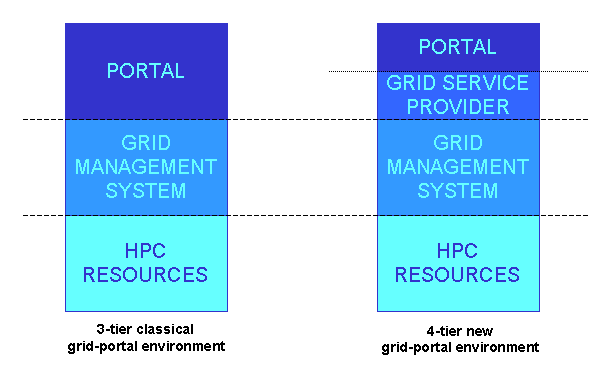
The PROGRESS project delivered a new architecture of grid-portal environments, which is presented in the picture below.

In the PROGRESS grid-portal environment the computing resources are managed by a Globus Toolkit 2.x installation, and are delivered by the PROGRESS Grid Resource Broker (GRB). The GRB is contacted by the PROGRESS Grid Service Provider whenever a user requests a computing job to be submitted for execution in the grid. The GRB decides where and how to run the application associated with the job based on the job requirements and the current status of the grid resources. The job description is passed in a form of a specially designed XML language: XRSL.
The grid services grouped into the GSP are available for use within the Web Portal, which is the prime user interface; the alternative is a migrating desktop kind of interface. The whole infrastructure is assisted by the Data Management System, which is used as the source of input data and the destination for results of computing experiments performed in the PROGRESS grid.
According to our knowledge at the PROGRESS project design phase, grid-portal environments that were deployed around the world at that time were implemented as 3-tier systems with HPC resources at the bottom, grid management systems (GMS) in the middle and portals in the top tier. This architecture works, but seems to be not flexible enough. In such a case when creating a new portal administrators are required to build both - the presentation and logical layers of the environment. Thus, there are as many installations of the logical layer as there are portals. This approach is also not very useful for business and market applications. The PROGRESS grid-portal environment introduces a new solution to this problem. Functions of the logical layer of the portal are grouped into a separated module running independently of the other modules in the environment. This module is called a grid service provider (GSP) and adds another tier to the system, right above the GMS and below the portal itself. The GSP works as a web services factory. The portal in the new architecture serves as the user interface and implements just the presentation functions: it collects the input from the users and displays the data obtained from services.

Using a GSP within the grid access environment makes the use of the grid resources more comfortable to the end users. The GSP serves as the source of grid resources: computing power, grid enabled applications, collaboration tools and others, to web portal and other user interfaces. Installed on a separate server connected to the grid access network the Web Services based GSP allows for easy building of numerous portals and other user interfaces utilizing the same grid services. Applications coming from one application repository can be accessed with the use of two or more different interfaces. What is more, it is easy to imagine creating various thematic web portals: a bioX portal, an electric engineering portal and a physics portal. Those thematic web portals may also use the same grid services and resources available through the GSP. The next advantage is the possibility of providing all GSP clients with computing resources belonging to two or more different grids. All these resources can again be available through one and the same module, the GSP, and can again be easily utilized by the multiple computing web portals.